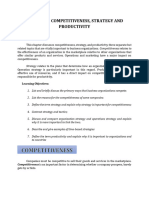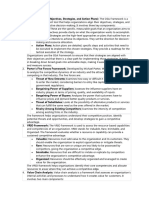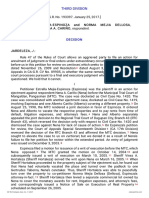0 ratings0% found this document useful (0 votes)
35 viewsCHAPTER THREE - Operations Management
CHAPTER THREE - Operations Management
Uploaded by
PattraniteThis document provides an overview of operations management and strategy planning. It discusses the different levels of strategy from corporate to functional to operations. Operations strategy involves designing processes and organizing them to produce goods and services that support higher-level business strategies. It also introduces Hill's Strategy Development Framework, which defines the essential elements of an effective operations strategy as operations design choices regarding process structure and infrastructure focusing on workforce capabilities.
Copyright:
© All Rights Reserved
Available Formats
Download as DOCX, PDF, TXT or read online from Scribd
CHAPTER THREE - Operations Management
CHAPTER THREE - Operations Management
Uploaded by
Pattranite0 ratings0% found this document useful (0 votes)
35 views1 pageThis document provides an overview of operations management and strategy planning. It discusses the different levels of strategy from corporate to functional to operations. Operations strategy involves designing processes and organizing them to produce goods and services that support higher-level business strategies. It also introduces Hill's Strategy Development Framework, which defines the essential elements of an effective operations strategy as operations design choices regarding process structure and infrastructure focusing on workforce capabilities.
Original Description:
Operations Management
Original Title
CHAPTER THREE- Operations Management
Copyright
© © All Rights Reserved
Available Formats
DOCX, PDF, TXT or read online from Scribd
Share this document
Did you find this document useful?
Is this content inappropriate?
This document provides an overview of operations management and strategy planning. It discusses the different levels of strategy from corporate to functional to operations. Operations strategy involves designing processes and organizing them to produce goods and services that support higher-level business strategies. It also introduces Hill's Strategy Development Framework, which defines the essential elements of an effective operations strategy as operations design choices regarding process structure and infrastructure focusing on workforce capabilities.
Copyright:
© All Rights Reserved
Available Formats
Download as DOCX, PDF, TXT or read online from Scribd
Download as docx, pdf, or txt
0 ratings0% found this document useful (0 votes)
35 views1 pageCHAPTER THREE - Operations Management
CHAPTER THREE - Operations Management
Uploaded by
PattraniteThis document provides an overview of operations management and strategy planning. It discusses the different levels of strategy from corporate to functional to operations. Operations strategy involves designing processes and organizing them to produce goods and services that support higher-level business strategies. It also introduces Hill's Strategy Development Framework, which defines the essential elements of an effective operations strategy as operations design choices regarding process structure and infrastructure focusing on workforce capabilities.
Copyright:
© All Rights Reserved
Available Formats
Download as DOCX, PDF, TXT or read online from Scribd
Download as docx, pdf, or txt
You are on page 1of 1
CHAPTER THREE: OPERATIONS MANAGEMENT
Operations Management and Strategy Planning
Strategy- the result of hierarchical decisions about goals, directions, and resources
o Corporate strategy- necessary to define the businesses in which the corporation will participate and develop plans for the
acquisition and allocation of resources among
Strategic business units- families of goods or services having similar characteristics or methods of creation
o Business strategy- defines the focus for SBUs; involves major decisions like which markets to pursue and how best to
compete in those markets
o Functional strategy- set of decisions that each functional area develops to support its particular business strategy
o Operations strategy- how an organization’s processes are designed and organized to produce the type of goods and
services to support the corporate and business strategies
Operations strategy- set of decisions across the value chain that supports the implementation of higher-level business strategies
Sustainability-
Multinational enterprise- an organization that sources, markets, and produces it and services in several countries to minimize
costs, and to maximize profit, customer satisfaction, and social welfare
o Multinational firms must answer “What is our supply chain strategy to meet slower growth in industrialized countries
and more rapid growth in emerging economies?”
Framework for Operations Strategy
Hill’s Strategy Development Framework was developed by Professor Terry Hill at Templeton College, Oxford University. It was
originally designed for goods-producing organizations but is now applicable for service-providing organizations. This framework
defines the essential elements of an effective operations strategy:
o Operations design choices- decisions as to what type of process structure is best suited to produce goods or create
services; typically addresses the type of processes, value chain integration, and outsourcing, technology, capacity and
facilities, inventory and service capacity, and trade-offs
o Infrastructure- focuses on non-process features and capabilities of the organization and includes the workforce,
operating plans, and control systems, quality control, organizational structure, compensation systems, learning and
innovation systems, and support services
You might also like
- Module 1 - Introduction Into Operations ManagementDocument20 pagesModule 1 - Introduction Into Operations ManagementBharathKumarM87% (15)
- Chapter 8 Assignment AnswersDocument20 pagesChapter 8 Assignment AnswersPattraniteNo ratings yet
- AASHTO - Knowel AASHTO LRFD Movable Highway Bridge Design Specifications (2nd Edition) with 2008, 2010, 2011, 2012, 2014, and 2015 Interim Revisions.-American Association of State Highway and Transpor.pdfDocument313 pagesAASHTO - Knowel AASHTO LRFD Movable Highway Bridge Design Specifications (2nd Edition) with 2008, 2010, 2011, 2012, 2014, and 2015 Interim Revisions.-American Association of State Highway and Transpor.pdfDoutor Inácio100% (1)
- Strategy Implementation PowerpointDocument14 pagesStrategy Implementation PowerpointThine RoseteNo ratings yet
- Chapter 3 AnswersDocument47 pagesChapter 3 AnswersPattranite100% (1)
- 3 - Cost Volume Profit AnalysisDocument1 page3 - Cost Volume Profit AnalysisPattraniteNo ratings yet
- The Rothschilds Stage Revolutions in Tunisia and EgyptDocument10 pagesThe Rothschilds Stage Revolutions in Tunisia and EgyptZeka Sumerian OutlawNo ratings yet
- OM and Strategic PlanningDocument20 pagesOM and Strategic PlanningPhooto StoridgeNo ratings yet
- Operations StrategyDocument26 pagesOperations Strategysulabhagarwal1985No ratings yet
- Mbaln 670 T01Document9 pagesMbaln 670 T01KateNo ratings yet
- Operations Strategy - Sbaa7027: Unit - IDocument117 pagesOperations Strategy - Sbaa7027: Unit - Ijugraj randhawaNo ratings yet
- OS Lec 1 AutosavedDocument24 pagesOS Lec 1 AutosavedParadise MessNo ratings yet
- We Are Now in A Generation Where Businesses Require The Use of TechnologyDocument2 pagesWe Are Now in A Generation Where Businesses Require The Use of TechnologyRuthchell CiriacoNo ratings yet
- Strategy, Levels, Strategic PlanningDocument29 pagesStrategy, Levels, Strategic PlanningNida BhattNo ratings yet
- Operation StrategyDocument12 pagesOperation StrategySukruth SNo ratings yet
- Business ProcessDocument13 pagesBusiness ProcessAshu MoglaNo ratings yet
- REVIEWERDocument14 pagesREVIEWERAudrey Ponce de leonNo ratings yet
- Week 10Document21 pagesWeek 10Arishragawendhra NagarajanNo ratings yet
- DBB3111Document8 pagesDBB3111purushothaman.teltonikaNo ratings yet
- Functional StrategiesDocument30 pagesFunctional StrategiesSheena Doria de VeraNo ratings yet
- What Is StrategyDocument58 pagesWhat Is StrategyAshu Poojari100% (1)
- Critical Success FactorDocument6 pagesCritical Success FactorRitesh GoelNo ratings yet
- Operations Strategy: Origins and New DirectionsDocument5 pagesOperations Strategy: Origins and New Directionsakarim23No ratings yet
- 4 Operations SrtrategyDocument37 pages4 Operations SrtrategyRosni ShahNo ratings yet
- Anaytical Reading 1Document6 pagesAnaytical Reading 1AleBribiescaNo ratings yet
- PGP21-OBII - Session 8 PDFDocument25 pagesPGP21-OBII - Session 8 PDFMegha SinhaNo ratings yet
- AE 24 ReportingDocument7 pagesAE 24 ReportingAnnamarisse parungaoNo ratings yet
- Organizational Strategy Organizational Design, Competences and TechnologyDocument42 pagesOrganizational Strategy Organizational Design, Competences and TechnologyPrashant NarulaNo ratings yet
- Biju Patnaik Institute of It & Management Studies, BhubaneswarDocument46 pagesBiju Patnaik Institute of It & Management Studies, BhubaneswarJuned AktarNo ratings yet
- Opman (Reviewer)Document4 pagesOpman (Reviewer)Rohainamae aliNo ratings yet
- Chapter 5 ORGANIZATIONAL ANALYSIS AND COMPETITIVE ADVANTAGEDocument23 pagesChapter 5 ORGANIZATIONAL ANALYSIS AND COMPETITIVE ADVANTAGEjecille magalongNo ratings yet
- Chapter 2. Competitiveness Strategy and ProductivityDocument14 pagesChapter 2. Competitiveness Strategy and ProductivityKhasandra FayeNo ratings yet
- Competitiveness Strategy and ProductivityDocument24 pagesCompetitiveness Strategy and ProductivitynbdvNo ratings yet
- 006 20190430 Functional StrategiesDocument4 pages006 20190430 Functional Strategiessonam swamiNo ratings yet
- Chapter 2 - Competitiveness, Strategy & Productivity - 2Document46 pagesChapter 2 - Competitiveness, Strategy & Productivity - 2JeSsica Joy P. SantiagoNo ratings yet
- Operations and Supply Chain JUNE 2022Document11 pagesOperations and Supply Chain JUNE 2022Rajni KumariNo ratings yet
- Frameworks On FairphoneDocument13 pagesFrameworks On FairphoneParveNo ratings yet
- Strategic Planning For Unilever United Arab Emirates LTDDocument17 pagesStrategic Planning For Unilever United Arab Emirates LTDkothanzawoo1979No ratings yet
- Chapter 9: Funtional Level StrategiesDocument4 pagesChapter 9: Funtional Level StrategiesAnonymous zHsbRY9No ratings yet
- Chapter 13 NotesDocument3 pagesChapter 13 NotesAdamNo ratings yet
- MBA - 4 Strategic ManagementDocument5 pagesMBA - 4 Strategic Managementmohammad.basitNo ratings yet
- Strategic Issues in Operation Management - Session 19 - 14C-0729 - Alva JerralynDocument14 pagesStrategic Issues in Operation Management - Session 19 - 14C-0729 - Alva JerralynJERRALYN ALVANo ratings yet
- Operations Management Summary Reviewer Chapter 1 To 3Document6 pagesOperations Management Summary Reviewer Chapter 1 To 3Ralph AbutinNo ratings yet
- Module 2 Strat MGTDocument11 pagesModule 2 Strat MGTAllen Gevryel Ragged A. GabrielNo ratings yet
- Opman SoftDocument72 pagesOpman SoftEllen MaskariñoNo ratings yet
- Strategic Management 2Document19 pagesStrategic Management 2alamzunaid448No ratings yet
- Introduction To Business StrategyDocument44 pagesIntroduction To Business Strategysohilibs73% (11)
- Mansi Jain PPT 2Document14 pagesMansi Jain PPT 2vinit PatidarNo ratings yet
- Om Chapter SummariesDocument35 pagesOm Chapter SummariesSHOBANA96No ratings yet
- Organisational StructuresDocument17 pagesOrganisational StructuresMiguelitoAlonso100% (1)
- Functional Level Strategies Plan and PoliciesDocument13 pagesFunctional Level Strategies Plan and PoliciesAnkita TiwariNo ratings yet
- Operation Management 2Document45 pagesOperation Management 2s100% (1)
- Business Policies and Decisions Bba 400Document85 pagesBusiness Policies and Decisions Bba 400nicollette ofrenNo ratings yet
- CO1Document33 pagesCO1vamsibuNo ratings yet
- Operations: StrategyDocument10 pagesOperations: StrategyPawan BhattaNo ratings yet
- Unit 1 SM NOTESDocument17 pagesUnit 1 SM NOTES6038 Mugilan kNo ratings yet
- Operation Management - Chapter 1Document15 pagesOperation Management - Chapter 1Diana May RameloNo ratings yet
- Introduction To Strategic ManagementDocument47 pagesIntroduction To Strategic ManagementPeyush AgarwalNo ratings yet
- Manasa T OperationmanagementassignmentDocument5 pagesManasa T OperationmanagementassignmentMANASA TNo ratings yet
- Competitiveness Strategy and ProductivityDocument34 pagesCompetitiveness Strategy and ProductivityRaymuel BelarminoNo ratings yet
- Strategy - Group 6Document17 pagesStrategy - Group 6Rwngshad Giri BasumataryNo ratings yet
- MIS: A Tool For Management ProcessDocument42 pagesMIS: A Tool For Management ProcessAmit SinhaNo ratings yet
- Strategic Analysis of Internal Environment of a Business OrganisationFrom EverandStrategic Analysis of Internal Environment of a Business OrganisationNo ratings yet
- How to Enhance Productivity Under Cost Control, Quality Control as Well as Time, in a Private or Public OrganizationFrom EverandHow to Enhance Productivity Under Cost Control, Quality Control as Well as Time, in a Private or Public OrganizationNo ratings yet
- Intermediate Accounting Chapter 3 ProblemsDocument34 pagesIntermediate Accounting Chapter 3 ProblemsPattraniteNo ratings yet
- Chapter 5 Assignment Regression AnalysisDocument7 pagesChapter 5 Assignment Regression AnalysisPattraniteNo ratings yet
- Chapter 13 AnswersDocument47 pagesChapter 13 AnswersPattranite100% (1)
- Chapter 5 AnswersDocument49 pagesChapter 5 AnswersPattraniteNo ratings yet
- Chapter Five: Cost Estimation: Total CostsDocument2 pagesChapter Five: Cost Estimation: Total CostsPattraniteNo ratings yet
- Chapter 4 AnswersDocument63 pagesChapter 4 AnswersPattranite100% (1)
- 2 - Cost Concepts and BehaviorDocument3 pages2 - Cost Concepts and BehaviorPattraniteNo ratings yet
- Work It!: Stretching and Zumba ExercisesDocument2 pagesWork It!: Stretching and Zumba ExercisesPattraniteNo ratings yet
- 4 - Cost Analysis For Decision MakingDocument2 pages4 - Cost Analysis For Decision MakingPattraniteNo ratings yet
- Chapter 11 SampleDocument6 pagesChapter 11 SamplePattraniteNo ratings yet
- Chapter Seven - Process Selection, Design, and ImprovementDocument3 pagesChapter Seven - Process Selection, Design, and ImprovementPattraniteNo ratings yet
- Chapter Six - Supply Chain DesignDocument3 pagesChapter Six - Supply Chain DesignPattraniteNo ratings yet
- CS 4038 - DM Course Outline (Fall 2021)Document4 pagesCS 4038 - DM Course Outline (Fall 2021)Nasreen AkhtarNo ratings yet
- Analysis of Acoustic Characteristics According To Design Parameter of DiaphragmDocument5 pagesAnalysis of Acoustic Characteristics According To Design Parameter of Diaphragmrajendra_krishna_1No ratings yet
- The Self in Western and Orientaleastern Concepts of The SelfDocument21 pagesThe Self in Western and Orientaleastern Concepts of The SelfJoy CieloNo ratings yet
- Authentic Materials in English As A Second Language ConversationDocument92 pagesAuthentic Materials in English As A Second Language ConversationVanne CandoNo ratings yet
- Lecture 1Document14 pagesLecture 1Laura Lozano BustosNo ratings yet
- Cancer Drug Discovery - Science and History-Springer Netherlands (Libro-2016)Document286 pagesCancer Drug Discovery - Science and History-Springer Netherlands (Libro-2016)ELMERNo ratings yet
- Kunci Pathway Wajib X K13NDocument39 pagesKunci Pathway Wajib X K13Nmochamadmusyaffa100% (1)
- Talent Attraction and SelectionDocument52 pagesTalent Attraction and SelectionArggie Roy BusallaNo ratings yet
- Gotzsche Critical Psychiatry TextbookDocument238 pagesGotzsche Critical Psychiatry Textbookronangoerl1100% (1)
- CreatePDF (3) - DikonversiDocument504 pagesCreatePDF (3) - Dikonversidewi ratnasariNo ratings yet
- Celebrate 6 Ano Test 2Document6 pagesCelebrate 6 Ano Test 2Isabelle Da Silva ValenteNo ratings yet
- Case Study Bajaj FansDocument9 pagesCase Study Bajaj Fansnightcrawler191No ratings yet
- Easa Part-147 Mtoe Checklist: 1. ScopeDocument36 pagesEasa Part-147 Mtoe Checklist: 1. ScopeTDHNo ratings yet
- A Very Wise King: A Legend Retold About The Wisest King There Ever WasDocument2 pagesA Very Wise King: A Legend Retold About The Wisest King There Ever WasREADY MtonezNo ratings yet
- Things You Need To Know To Feel More Comfortable in Cegep/University KnowledgeDocument3 pagesThings You Need To Know To Feel More Comfortable in Cegep/University KnowledgeRyan GhaemiNo ratings yet
- RSS NAS Sample Questions-1Document2 pagesRSS NAS Sample Questions-1ssayem5142No ratings yet
- Educational Attainment and Drug UseDocument30 pagesEducational Attainment and Drug UseKayla WysockiNo ratings yet
- A State Space Single-Phase Transformer Model Incorporating Nonlinear Phenomena Magnetic Saturation and Hysteresis For Transient and Periodic Steady-State AnalysisDocument5 pagesA State Space Single-Phase Transformer Model Incorporating Nonlinear Phenomena Magnetic Saturation and Hysteresis For Transient and Periodic Steady-State Analysissreekantha2013No ratings yet
- Mabo V QueenslandDocument5 pagesMabo V QueenslandsigourneyNo ratings yet
- (Ebooks PDF) Download Supervision Today! 9th Edition (Ebook PDF) Full ChaptersDocument49 pages(Ebooks PDF) Download Supervision Today! 9th Edition (Ebook PDF) Full Chaptersatomboirger100% (5)
- Survival School: Learnenglish Kids Listening DownloadsDocument3 pagesSurvival School: Learnenglish Kids Listening DownloadsTín PhạmNo ratings yet
- Manuscript Template Jurnal Research AipvikiDocument7 pagesManuscript Template Jurnal Research Aipvikisetiawan antoNo ratings yet
- Modulo 4 - A EngDocument20 pagesModulo 4 - A EngCARLA CASASNo ratings yet
- 37 Mejia-Espinoza - v. - Cari - O20170724-911-11avor4 PDFDocument9 pages37 Mejia-Espinoza - v. - Cari - O20170724-911-11avor4 PDFAlyssa Fatima Guinto SaliNo ratings yet
- Cigre 464Document54 pagesCigre 464namsaigon316No ratings yet
- Igbt Cm100du-12f PDFDocument4 pagesIgbt Cm100du-12f PDFJose GutierrezNo ratings yet
- 7th Grade Math Course SyllabusDocument3 pages7th Grade Math Course Syllabusapi-485606042No ratings yet







































































































